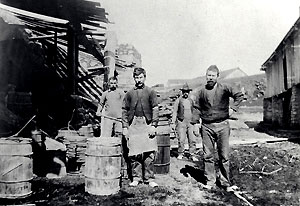Preservation efforts at UC Santa Cruz have received a major boost from the State Historical Resources Commission: approval for listing UCSC's Cowell Lime Works Historic District on the National Register of Historic Places.
The historic district, which was nominated by UCSC for listing, is an area of about 30 acres around the main entrance of the campus on either side of Coolidge Drive. It includes historic buildings, lime production features and related support facilities that date to the latter half of the 19th and early 20th centuries, when industrialist Henry Cowell operated the complex and support facilities on what is now campus land.
"We're working with local historian Frank Perry, who helped us on the National Register nomination, to come up with ways to interpret the site to the public," said UCSC senior environmental planner and archaeologist Sally Morgan.
Morgan said the campus would like to construct guideposts to help people follow the self-guided walking tour Perry described in his book Lime Kiln Legacies, being published by the Museum of Art and History in Santa Cruz.
Henry Cowell, a major industrialist in central California, operated a large complex of industrial lime production and support facilities scattered throughout what is now campus land.
Interest in campus historic preservation has intensified since the awarding of a $100,000 Getty heritage grant in 2004. (
One idea for future work, Morgan said, is to stain many of the historic buildings on campus white for consistency with the historic appearance of the onetime farm buildings. Barn H, in the campus corporation yard, was the first to get the old-fashioned stain, to resemble the whitewash used historically.
An overall plan to enhance the historic appearance of the district is now being finalized.
The campus has also applied for a grant to transform the historic Paymaster's House, a small stone building near the campus entrance, into a curatorial and archaeological research facility. The grant, which would include seismic work, is being considered by the California Cultural and Historical Endowment.
Included in the historic district are the Cooperage, lime kilns, and several small quarries along Coolidge Drive. Limestone from these and other larger quarries was burned in the kilns, and the product was packaged in barrels manufactured at the Cooperage (the long structure on stone pillars). The remnants of the tramway trestle and rail bed used to carry limestone and redwood from the upper campus can also be seen along Coolidge Drive. Also included in the district are several of the barns and the Blacksmith's Shop used in the care of the draft animals used on the limeworks and ranch.
Also a part of the district are the historic horse barn, now the Barn Theater, the Cook House (now the campus Admissions Office), where ranch workers were fed, as well as ruins and archaeological remains of several workers' cabins. The district also extends to the ranch owner's house, known as Cardiff House--now the Women's Center--and the entry gate and drive to the house, which can been seen on High Street just east of the campus entrance.
According to historian Frank Perry, Henry Cowell dominated the masonry supply business in northern California during the late 1800s. When he died in 1903, he owned property in 23 California counties. Besides lime-manufacturing plants, dairies, and cattle ranches, he was involved in banking, real estate, shipping, warehousing, and had financial interests in a railroad and hotel. Due to the family's philanthropy, the Cowell name is on a college at UCSC, several university health centers, and several parks. The S. H. Cowell Foundation continues to be one of northern California's major foundations, supporting social causes. Henry Cowell and his legacy have had and continue to have an important impact in northern California.
###
Photos are available upon request.



